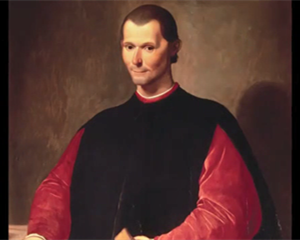Hey there I'm Mike Rugnetta, this is crash course theater and today we're gonna be moving from the Middle Ages into the Renaissance, a time of discovery, innovation, beauty, sophistication and comedy.
嘿 大家好 我是迈克·鲁格内塔 这里是“戏剧速成小课堂” 今天我们将离开中世纪进入文艺复兴时期 那是一个充满了探索、创新、美丽、复杂和喜剧的时代
In this episode, we're gonna take a trip to Italy, exploring the elegance of the neoclassical revival and the invention of one of theirs best-loved popular forms—Commedia Dell'arte.
本集我们会来一段意大利之旅 探索新古典主义的优雅登场以及他们发明的最爱的流行形式之一—即兴喜剧
That's right. The Golden Age of the poop joke has dawned.
是的 迎来了恶俗笑话的黄金时代
The Renaissance in Italy lasts from roughly 1,300 to 1,600.
意大利的文艺复兴持续了大约1300至1600年
That earlier date overlaps pretty significantly with the late Middle Ages.
那之前的早些时候和中世纪晚期有相当大的重叠期
Because no one really puts out press releases letting everyone know when a historical era has ended.
因为没有人会发布新闻稿什么的来通知大家一段历史时期结束的确切日期
Plus: cultural change takes time.
而且 文化上的转变需要时间来慢慢沉淀
A lot of the forms we'll talk about today were in vogue at the same time as those Cycle plays and to their present wagons.
我们今天讨论的许多形式都是在当时比较流行的形式 就像循环剧和当时的四轮马车一样
But Mystery Plays and Passion plays never really caught on in Italy, which may explain why other genres flourished.
不过神秘剧和耶稣受难剧并未在意大利真正流行起来 这或许就是其他类型的戏剧会“大火”的原因
If the Middle Ages were about God, and yes, I am generalizing, because they were also about feudalism and Crusades, itchy clothing and the plague, then the Renaissance was about people and also still the plague.
如果说中世纪讲述的是“上帝” 是的 我在总结 因为中世纪还讲述了封建主义及十字军东征、瘙痒的衣服和瘟疫 那么文艺复兴就是在讲述“人” 外加瘟疫
The Renaissance introduced humanism—the idea that earthly life isn't just a veil of tears that might lead to heaven if you're good, but is maybe worthy in and of itself.
文艺复兴时期引入了人道主义 即世俗生活不只是假如你是好人就能带你通向天堂的眼泪面纱 但世俗生活本身或许是具有某些价值的
This encouraged an upsurge in human achievement: music and medicine and visual arts and physics and theatre, too.
这激发了人类获取成就的高潮 在音乐、医学、视觉艺术、物理和戏剧方面
Hey, that's us.
嘿 说的就是我们

Theater starts moving forward by looking backward.
戏剧是在回顾中前进的
We know from our episode on Hrotsvitha that Roman drama never disappeared.
从赫罗斯维塔那集里我们知道罗马戏剧从未消匿过
The plays of Terrence and Plautus and Seneca were read throughout the Middle Ages. But they weren't performed.
特伦斯、普劳图斯以及塞内卡的戏剧作品在整个中世纪都在被人们习读 但是没有被表演出来
They were enjoyed for their style in the case of the comedies and their moral lessons in the case of the scenical tragedies.
他们的喜剧风格以及在戏剧性悲剧的道德教训方面都很受欢迎
In the 1300s, Italian writers started trying to make these plays their own, but it took a while for them to come up with anything as distinctive as Hrotsvitha's work.
14世纪意大利作家开始尝试将这些戏剧创作成自己的作品 但是对他们来说想要创作出和赫罗斯维塔创作的那样与众不同的作品着实需要花费时日
Most early attempts were based on Roman tragedies, but by the late 1390s, Italians were writing Roman style comedies too.
早期的尝试大多基于罗马悲剧 直至1390年代末期意大利人也开始创作罗马风格的喜剧
Twins and mix-ups and you know all the good stuff you come to expect.
双胞、杂交、 你懂的 都是大家所期待的好东西
For a while these plays were written in Latin and they weren't intended for performance.
这些戏剧有段时期是用拉丁语编写 且不进行表演
But in 1429, a bunch of Plautus's plays were found and when Constantinople fell a bunch of Greek manuscripts returned to Italy.
直至1429年普劳图斯的很多戏剧作品被世人挖掘 此外君士坦丁堡陷落之时有一些希腊手稿重回意大利
By the late 1400s, some Nobles wondered: hey, what if we turned the banquet hall into a theater and put on Plautus?
到了15世纪后期一些贵族突发奇想:嘿 如果我们把宴会厅变成剧院 然后上演普劳图斯的戏剧作品怎么样?
And then a few years after that they wondered: hey, would it be more fun if plays were written in the Vernacular rather than in Latin and spoke to how we live now?
几年后他们又突发奇想:嘿 如果戏剧不是用拉丁语撰写 而是用本国语言撰写来描绘国民当今的生活 那样岂不是更有趣?
And then presto Neoclassical Plays so-called, because they are classical and also new.
之后所谓的新古典主义戏剧出炉 因为它们又新又古典
At first, writers churned out Plautus like comedies with young lovers mean parents and cheating wives.
起初作家们粗劣地创作出普劳图斯式喜剧 讲述年轻恋人、刻薄的父母和出轨的妻子之间的故事
Even Niccolo Machiavelli got in on the action with the Mandrake.
甚至连尼古拉·马基雅维利也加入了曼德拉草行列
These comedies were called Commedia Erudita or Erudite Comedies. Because they were based on classical models that you had to be well-read to know.
这些喜剧被称为喜剧博学或者博学喜剧 因为它们是基于古典模型的 你必须博览群书才能读懂
But were they all that classical? Yes and no.
但是 它们都如此经典吗?是也不是
By 1498, Aristotelis Poetica was back in circulation, and people were actually reading it by 1550.
到了1498年 亚里士多德的《诗学》又重新流行起来 到了1550年 人们开始真正地研读它
But their takeaway was pretty different from Aristotelis.
但是他们的结论和亚里士多德的很不一样。
Italian writers got rid of choruses, they moved towards greater realism, and often wrote tragedies with happy endings, which we now call Tragiccomedies.
意大利剧作家抛弃了合唱 转向了更大的现实主义 通常会给悲剧设计一个圆满的结局 被称为悲喜剧
Italians decided that tragedy had to teach useful moral lessons—an idea borrowed from the Roman critic Horace. And they really ran with it.
意大利人认为 悲剧必须利用有用的道德教训来教化人们—借用了罗马评论家贺拉斯的观点 他们也做到了
Almost all of these plays were privately produced by courts or schools.
几乎所有的戏剧都是由法院或者学校私下创作的
They were staged to honor some person or event.
用来纪念某人某事
Nobles made up the audiences and Nobles usually made up the actors too.
贵族们充当观众 通常也充当演员
If you were a lower class person, your chances of seeing Commedia Erudita in performance were slim.
如果你是一名底层群众 那么你看到博学喜剧的机会会很渺茫
But luckily, Commedia Erudita wasn't the only theatre game in town.
好在博学喜剧并不是城镇里唯一的戏剧形式
A lot of Italian Renaissance theaters innovation didn't have much to do with the plays themselves.
意大利文艺复兴时期许多对剧院的改革都与戏剧本身没有太大关系
Italians were wizards of stage craft.
意大利人是舞台艺术的奇才
They were like: I'll see your trapdoor and your medieval Hellmouth. And I'll raise you crazy advances in perspective, and also rigging.
他们说:我要看看你们的活板门和中世纪的地狱之口 我会给你们一些疯狂的建议 还有绳索设备
So, oh he's got somewhere to go that guy.
所以 哦 那家伙要去某个地方
The staging Renaissance gets started when 15th century Italians rediscover Vitruvius's treatise De Architectura, which was written around 15 BCE and is basically the poetics of architecture, chockblock with set design protips.
15世纪意大利人重新发现维特鲁威的《建筑论》时文艺复兴的舞台表演便开始了 《建筑论》写于公元前15年 内容主要是建筑诗学、带有设计提示的止动楔
The discovery of a single point perspective painting transformed theater sets too.
单点透视画法的发现也改变了剧院的布景
Helping them look three-dimensional, though it helps if you're the Emperor or the Duke or the count or whatever.
使剧院布景看着立体感更强 如果你是皇帝或者公爵或者伯爵之类的人会有帮助
Because single point perspective really only works if you're sitting smack in the center which is where the nobility were placed typical.
因为单点透视只有在你恰好坐在中间位置的时候才有效 而中间位置一般都是贵族的专属位置
In the 17th century, we get shifting scenery which is accomplished with wing panels that slide in and out on grooves in the floor among other methods.
17世纪时又有了通过翼板来实现的移动式风景 可以在地板的凹槽上通过其它方式滑进滑出
When a scene changed, wing panels slid out.
场景改变时翼板便会滑出
Each set of painted wings that disappeared revealed more just behind.
每一组消失的彩绘翼板后面都会呈现更多的画面
In the late 1500s, gardens and banquet halls give way to permanent purpose-built theaters, possibly the first in Europe since Roman times.
16世纪晚期 花园和宴会厅被专门用来建造永久性剧院 这大概是欧洲自罗马时代之后的先例













